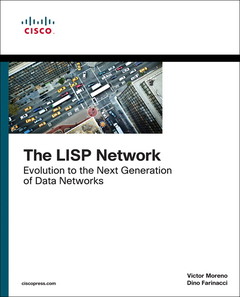Description
LISP Network, The
Evolution to the Next-Generation of Data Networks
Networking Technology Series
Authors: Farinacci Dino, Moreno Victor
Language: English
Subjects for LISP Network, The:
192 p. · Paperback
Description
/li>Contents
/li>Biography
/li>Comment
/li>
In an era of ubiquitous clouds, virtualization, mobility, and the Internet of Things, information and resources must be accessible anytime, from anywhere. Connectivity to devices and workloads must be seamless even when people move: location must be fully independent of device identity.
The LISP protocol makes all this possible. LISP is address-family agnostic, so it can encapsulate any protocol within another, and route across virtually any network. LISP applications include very-large-scale virtualization for WANs and multi-tenant data centers; host mobility and location services across data centers; advanced mobile networks; ad-hoc networks; IPv6 enablement, seamless site multi-homing; workload mobility; cellular mobility; multicast and traffic engineering, and more.
The LISP Network is the first comprehensive, in-depth guide to LISP concepts, architecture, techniques, and applications. Co-authored by LISP co-creator Dino Farinacci and two pioneering developers of Cisco's LISP implementation, this guide will help you plan and implement LISP in any data center, WAN edge, or service provider core network. Largely implementation-agnostic, this book offers actionable answers to questions such as:
- What problems does LISP address, and how does it address them?
- How does LISP work?
- What are LISP's applications, and how do you architect LISP solutions for each application?
- How does LISP fit with SDN, IoT, and IPv6?
- What is LISP's future?
The LISP Network concludes with detailed deployment case studies of several LISP applications, each drawn from the authors' pioneering experience.
- 1. LISP and the Future of Networking
- 2. LISP Architecture
- 3. LISP Unicast Handling Fundamentals
- 4. LISP Multicasting Fundamentals
- 5. Traffic Engineering and LISP
- 6. LISP Host Mobility
- 7. LISP Network Virtualization/Multi-tenancy
- 8. LISP and the Multi-homed Internet Edge
- 9. Programmability, Policy and LISP: Integration and Application
- 10. LISP and the Internet of Things
- 11. LISP Application Deployment, Configuration and Troubleshooting
Victor Moreno is a Distinguished Engineer at Cisco Systems responsible for the definition of next-generation network architectures. Victor has more than 20 years of industry experience focused on enterprise and data center network design and architecture. A recognized expert in his field, Victor holds several patents which are at the foundation of the key protocols and networking technologies that have enabled the evolution of networking to its current state. He has worked directly on the designs of global enterprises and service providers and has done extensive research on the topic of network virtualization, being a driving force within Cisco and earlier Digital Equipment Corporation for new product definition and technological direction. Victor is the co-author of the Cisco Press title Network Virtualization and has published a multitude of technical papers and articles on behalf of Cisco Systems. Victor holds a degree in electrical engineering from the Simón Bolívar University, as well as master’s degrees and specializations from the Universities of York, Cambridge, and Stanford. Victor is an active contributor to the definition, implementation, and standardization of the Locator/ID Separation Protocol (LISP).
Dino Farinacci is a software engineer by trade and a technology visionary by passion, advancing the state of the art in computer networking. As one of the first Cisco Fellows, Dino holds more than 40 Internet and networking-related patents and has been a major IETF contributor for nearly 30 years with approximately 50 RFCs and Internet Drafts published. Dino is the founder of lispers.net, a nonprofit engineering organization, where he now focuses on design and deployment of LISP for IoT, cryptocurrency, and 5G mobile networks.
Dino is one of the original RFC co-authors of L
- Co-authored by one of LISP's creators, Dino Farinacci, co-author of several key LISP RFCs
- Covers concepts and architecture
- Explains how LISP works, where and how it can be deployed, and what problems it solves



